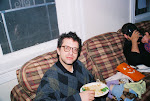We now have a better view of what was going on in the Reconstruction years while the British were busy holding meetings about how to administer the natives (1902-08).
From America, and especially Black America, came several streams.
There was the successful joint African Methodist Episcopal Church growth, spawning dozens of "Ethiopian style" (Bengt Sundkler, 1960) African Methodist (type) churches. There were the Gospel singers of 1892. There was Alexander Dowie in Chicago's Zion City, seeding healing churches at the millennium.
Engaging [God/Ancestor] directly bothered authority. Shouting out in tongues, possessed writhings, all-night-long "prayers," ran counter to job-related regularities. James Kiernans says that congregations were all about managing the tension between the collective and the destablizing individual communicant. This same contradiction and resolution played out on the national stage, between the NAD and the churches.
The heavy presence of black Americans: Jean Comaroff's (Body of Power) insight, repeated by Maxwell: these were communities with the same class predicament, being shoved aside by new modes of integrating production, losing their hold on the land, on both sides of the Atlantic — communicating and "converting" each other to a direct-access form of mobilizing.
John Higginson says that the IACs (Independent black Christian churches): "swept over both town and countryside in southern Africa once thousands of Africans were driven from the land by punitive forms of taxation and land enclosure."
In other words, after "conquest".
By 1900 the countryside was pretty much proletarianized. Sharecropping was already under pressure. From 1903 to 1908, the old regime on the land was restored to its pre-S.A. war mode, or extended in new ways. "By 1908 numerous African peasants [throughout southern Africa] found themselves squeezed beyond endurence." (Higginson, 58). In the same period parts of the South African countryside turned to pentacostalism suddenly, "whole native congregations" joining the Apostolic Faith Mission from 1908, "thousands" of new members appearing on the southern highveld (Maxwell, "Historicizing Christian Independency," JAH 40, 2 (1999), 249). There was Buchler, Le Roux (with "35" African preachers under him in 1909: Maxwell, 1999, 248), Mahon, and then a handful of American midwesterners, with experience gleaned from the interracial Azusa revival in Los Angeles, California, in 1906 — the Pentacostals, initiating the worldwide movement in South Africa (in Wakkerstroom and Doornfontein (Johannesburg) in (at first) a non-racial fraternity.
Eddies and currents continued to flow. Joseph Booth, a missionary for radical Adventist sects, was in Malawi from 1892 intermittantly. Pentacostals made rain, and founded "Pentacostal villages"; Watchtower people eradicated witchcraft and (Mwana Lesa) the chiefs' enemies, and whole villages converted to "Wa-Kitawala" (Watchtower) too. By 1908, Kamwana, Sindano, and other Watchtower representatives began articulating an ideology of liberation "in this world as well as the next" (Higginson "Liberating the Captives," in Journal of Soc. Hist., fall 1992, 60), and grew. And, some thirty or more "IACs" by 1910 (Martin West, 1972).
Tuesday, May 20, 2008
Subscribe to:
Post Comments (Atom)

No comments:
Post a Comment